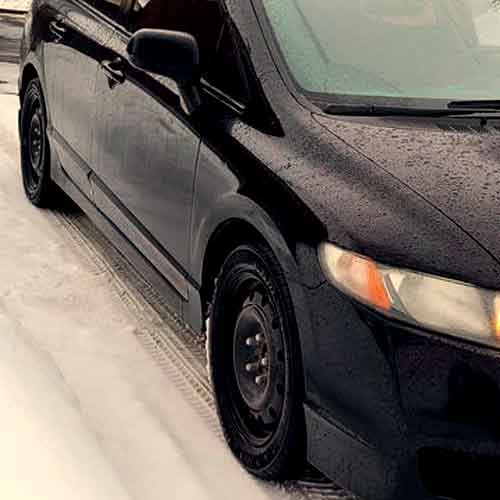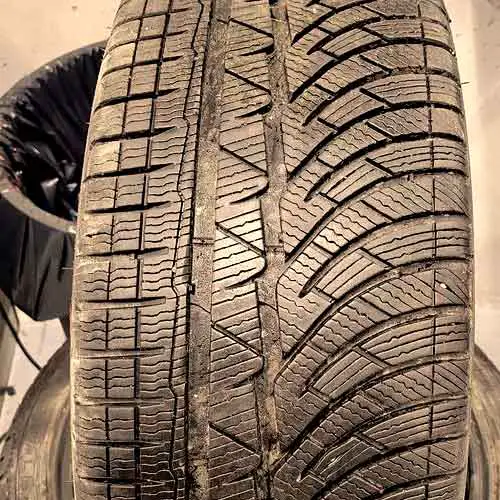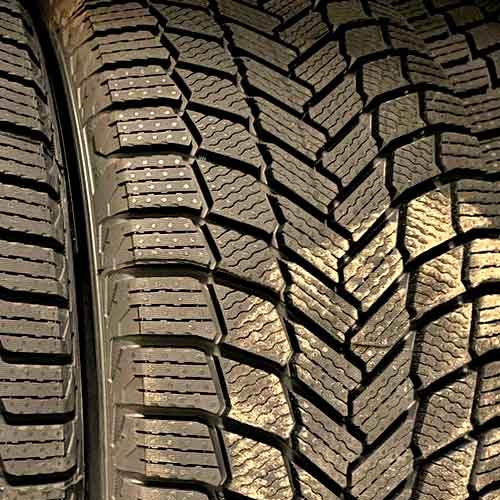Both the Michelin X Ice Snow and the Michelin Pilot Alpin PA4 are acclaimed performers in the winter tire landscape, each offering different strengths in handling, endurance, and ride comfort, thus providing numerous choices for different driver expectations and terrain demands.

Table of Contents
Available Sizes
The Michelin Pilot Alpin PA4 (review) comes in 51 total sizes in 17 to 21 inches (with following specs).
- Speed ratings: H, V and W.
- Load ratings: SL and XL.
- Tread depth: 10.5/32″ on all.
- Weight: 10 to 36 lbs.
- Tread warranty: 30k miles.
On the other hand, the Michelin X-Ice Snow (review) comes in 125 total sizes in 15 to 22 inches. They have following specs.
- Speed ratings: T and H.
- Load ratings: SL and XL.
- Tread depth: 10.5/32″ on all.
- Weight: 16 to 40 lbs.
- Tread warranty: 40k miles.
Tread Pattern
Starting with the Michelin Pilot Alpin PA4, the tire exhibits an asymmetrical tread design.

The tread pattern encompasses four main ribs in total, with the central one being continuous.
One side of this central rib presents a smooth and straight surface, void of edges, while the other side is serrated with the inclusion of sharp edges and notches. In addition, this rib is enriched with a mix of numerous sipes and slanted slits.
Moving along, the next rib visible on the tread, situated towards the serrated side of the central rib, covers the majority of the tread’s area.
This rib boasts chamfered outer edges and consists of a blend of rectilinear and interlocking siping, oriented at various angles.
You can also observe curving in-groove notches that run parallel to the lateral tread voids separating these blocks from one another.
As we shift towards the other side of the tire, we find things more closely packed. Nevertheless, you can still identify similar in-groove notches and longitudinal slits, although they do not divide the lugs.
On the other side, the Michelin X-Ice Snow also flaunts a unique, and directional tread design.

Its tread comprises four circumferential channels, emanating from four ribs in the very middle (though, there are total of six ribs, if you also count shoulders).
The narrowest, most challenging groove is positioned centrally and is crafted by two ribs that hold blocks adorned with multiple sharp edges, snow-vices, chamfered edges and a mixture of interlocking and rectilinear siping.
The surrounding blocks (further out), only carry wave-like sipes though, and don’t have as many biters.
And lastly the shoulder lugs are the most aggressive.
They carry thickest siping, and have sharp zigzag teeth on their lateral sides.
Comfort Levels
Tire comfort is primarily determined by road noise and vibration absorption.
Starting with road noise, which is essentially air particles colliding with the tire tread, the Michelin X-Ice Snow fares better due to its more closed tread design.
This restricts the free movement of air particles, reducing the force with which they hit the walls, and consequently decreasing the noise generated.
However, the Michelin Pilot Alpin PA4 shines in the area of vibration absorption, exhibiting superior settling abilities.
Hence, both tires perform admirably in terms of comfort.
Winner: Michelin Alpin PA4
Tread Life
The tread life of a tire is greatly affected by rolling resistance, and in this aspect, the Michelin X-Ice Snow stands tall. Its lighter weight exerts less pressure on its lugs as they rub against the road.
On the flip side, the Michelin Pilot Alpin PA4, with its slightly larger average weight and wider grooves, subjects each lug to substantial pressure as it rolls.
This leads to excessive heat, which in turn increases rolling resistance and accelerates rubber wear.
But here the difference between the two tires, is so low, that I wouldn’t rate one over the other still. That’s why it makes sense, why both tires offer you with 40k miles warranty.
Winner: Both!
Snow Performance
The commendable performance by both boys here, in varying snowy conditions is nothing short of impressive, with each yielding very similar outcomes.
However, a decision favoring one over the other has to be made and for this, I’d lean towards the Michelin Pilot Alpin PA4, as this tire still demonstrates a slight superiority, notably on fluffy snow surfaces.
Let me explain why.
So this tire basically, comes with a more aggressive array of biters, prominently dispersed over its asymmetric tread, which allows for enhanced snow-to-snow contact.
This design enables fluffy snow to be effectively trapped within the tire’s interlocking grooves and snow-vices, facilitating a stronger ground contact with the captured snow.
This inventive design boosts traction since snow typically adheres more effectively to other snowflakes than it does to rubber.
The Michelin X-Ice Snow, featuring a relatively more crowded lug design, falls short of delivering similar outcomes. Consequently, the Michelin Pilot Alpin PA4 emerges as the superior choice in snowy conditions.
Winner: Michelin Alpin PA4
Wet Traction
The wet traction of a tire is largely determined by its tread design and the rubber compound used. These factors reveal the tire’s gripping and hydroplaning resistance capabilities. Let’s dissect these elements individually.
Wet Grip
The Michelin X-Ice Snow emerges as the winner in terms of wet grip.
The tire exhibits quicker braking by 5 feet and outperforms by a solid 2 seconds in handling during lap tests.
The secret lies in its thermally adaptive softer rubber compound and more flexible lugs, which allows its sipes to generate improved suction for incoming water particles. Its multi-angled siping provides grip in all directions.
In contrast, the Michelin Pilot Alpin’s angled sipes lack comparable flexibility.
This results in the X-Ice Snow outshining its competitor in wet grip performance, although it lags slightly in hydroplaning resistance.
Winner: Michelin X Ice Snow
Hydroplaning
Hydroplaning is a condition where the tire tread loses contact with the road due to a water layer buildup, causing the tire to skid over water. It typically occurs in wet or rainy conditions when significant standing water is present on the road.
The Pilot Alpin PA4 shines in this category, particularly during cornering.
Two different tests, namely, straight and curved aqua tests, were conducted to measure this.
And although there’s only a slight difference between both tires in straight-line hydroplaning, the Pilot Alpin PA4 pulls ahead significantly in the curved test, underscoring its impressive hydroplaning performance.
Winner: Michelin Alpin PA4
Ice Performance
In icy conditions, the Michelin X-Ice Snow outperforms its competitor, showcasing superior braking abilities with an improved average braking distance. Wondering why it stops and accelerates faster, as indicated by test results? It’s largely due to its meticulously crafted tread features.
Equipped with a central area boasting slanted incisions and snow vices, alongside dual angled siping, the Michelin X-Ice Snow exhibits remarkable biting abilities. This tire markedly surpasses its predecessor in performance over icy terrains.
Conversely, the Michelin Pilot Alpin PA4, endowed with larger tread voids and fewer notches, doesn’t fare as well.
The central tread area, critical for efficient braking, faces challenges in securing a firm grip on compact ice due to its wider lateral tread voids.
Its larger lugs inhibit flexibility, preventing the biters from effectively gripping the icy surface.
And its angled sipes lack sufficient depth and flexibility to effectively bite into ice compared to its rival, leaving the Michelin Pilot Alpin PA4 trailing in the icy performance test against its counterpart.
Winner: Michelin X Ice Snow
Dry Traction
Dry traction is assessed based on two critical aspects: directional grip and lateral traction. Let’s break them down individually.
Directional Grip
This aspect gauges a tire’s grip as it rolls straight, placing significant importance on the middle section of the tire.
In this regard, the Michelin X-Ice Snow does better (very marginally), owing to its slightly more streamlined structure and central area (of interlocking lugs), which together facilitate faster braking and acceleration.
Conversely, the Michelin Pilot Alpin PA4 falls short due to its broader grooves and asymmetric design, which are less optimal for straight rolling, such as on highways.
Though since the difference is only 0.2 feet, I am going to tie this round.
Winner: Both!
Lateral Traction
Lateral traction, the sideways grip of a tire, hinges on two metrics: the contact patch and the rubber composition.
A close examination of these two factors reveals the shortcomings of the Michelin Pilot Alpin PA4.
Its broader grooves don’t provide sufficient ground contact, and under larger weight, its lugs bend more while cornering.
This leads to oversteering and understeering, resulting in delayed steering feedback.
Winner: Michelin X Ice Snow
Summing Up
To sum it all up, the Michelin Alpin PA4 shines in fluffy snowy conditions, while the X-Ice Snow outclasses its rival on compact snow and ice, offering shorter braking distances and superior handling times.
On both dry and wet surfaces, the Michelin X-Ice Snow holds the reins, despite the Pilot Alpin PA4 showcasing exceptional hydroplaning resistance.
Other than this, the X Ice offers you a more fuel efficient option, and lasts longer too, though the overall comfort levels are better on its competitor.
Actually, its usually the case, where you compromise a little on comfort, you get better fuel efficiency, and vice versa.
And yes, as fuel is tied to rolling resistance, which is mostly directly proportional to treadwear, (in case of winter tires, for the most part), it also affects overall tread life.